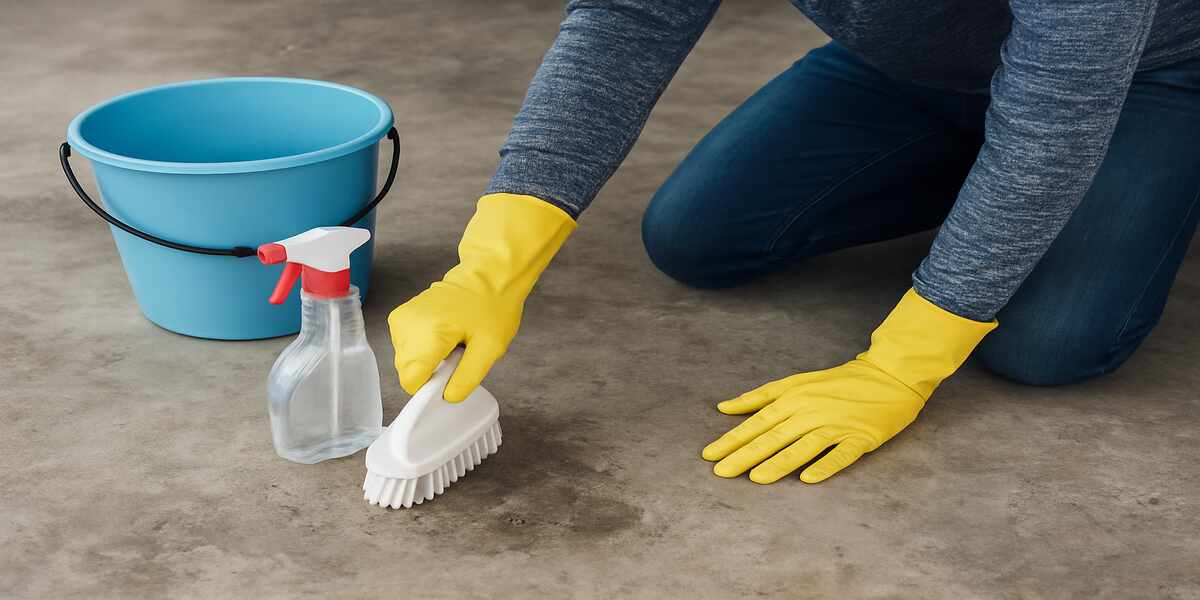When you enter your house or other surrounding area, have you ever observed how boring and dirty the concrete floors are? Clean Concrete Floors is strong yet not permanent, as they are located in the garage, in the basement, on the patio, and in the driveway. They will eventually acquire dust, dirt, grease and even hard-to-remove stains. This is why it is preferable to know how to clean concrete floors and make them look fresh and last longer.
The good news, however, is that with the help of no costly products for Cleaning Concrete Floors and no complicated methods, you can attain a spotless look. Actually, after knowing how to clean Concrete Floors in the right way, both in the house interior and outside the door, cleaning will become very easy.
The Importance of Cleaning Concrete Floors.
Concrete floors are strong; nevertheless, they are porous and therefore absorb dirt, lube oils and even water. Unless you clean them, such surfaces can acquire permanent stains, unpleasant smells, and even mould in damp places such as basements. Also, the dirtier it can get, the more difficult it is to get off the harder it gets to clean. So, it is not only about the appearance that one would need to understand how to clean concrete floors the best possible way, but it is also about preserving your investment. Whether you are engaging in basic maintenance or you are bond cleaning rockingham, good maintenance will make your concrete floors appear immaculate and durable.
Cleaning Concrete Floors Indoors.
For clean concrete floors, the floor of the indoor concrete is frequently sealed or polished, and in such a case, it requires a milder cleaning method to keep the finish and durability. To maintain them streak-free and spotless, follow these easy but useful steps:
1. Sweep or Vacuum First
Clean the surface by sweeping off all loose dirt, dust and debris before mopping it. A hard broom is good as a sweeper, though you can get a vacuum cleaner with a brush attachment. This ensures that the small particles do not scratch the sealed surface during mopping. Attention to corners and edges will make sure that there is no dust and even no grit left to ruin the floor in the wet cleaning process.
2. Mop with a Mild Solution
When the dust is cleared, put together a bucket of warm water and a small amount of mild dish soap or a pH-neutral cleaning solution. These weak solutions work well in cleaning without robbing the sealant or polish. The use of harsh chemicals such as ammonia, vinegar or bleach should be avoided since this dries the finish. Clean the whole floor with a wet mop, and change the water as often as you can.
3. Cleanse Tackle with Baking Soda.
Another thing is that cleaning concrete floors may have stubborn stains attributed to spills or heavy foot traffic. To dress them, pour water into the baking soda to create a thick paste. The most important thing is to set it on the impure surface and let it rest for ten minutes or so to allow the dirt to come off. So, you can give a gentle, scratch-free cleaning with a brush. Rinse it thoroughly with clean water, and it should be dried to preserve the shine.
4. Floor Drying
After mopping or spot cleaning, the floor should be kept dry since too much water may cause streaks or damage. On the rest of the water, apply a microfiber mop that is either dry or a clean towel. A dry and clean floor helps shine the floor and prevents slip hazards. This is important for cool rooms or basements where the floor takes a longer time to dry naturally.
Cleaning Concrete outside your home.
Outdoor concrete slabs such as patios, driveways and garages are subjected to unending mud attacks, oil spill attacks and the harsh weather. If you want to ensure all floors are clean and well-maintained, then these tips are more helpful:
1. Clear All Loose Debris
In the beginning, to clean concrete floors, you can start by sweeping, which leaves dirt and twigs with a stiff-bristle outdoor broom. The next step is to focus on the corners and edges. Where more debris is found. It simplifies the cleaning process, and it also prevents clogged drains when we do washing on the concrete surface.
2. Employ a Pressure Washer
There is no other way that is as efficient as a pressure washer for a deep and thorough clean. In order to avoid chipping or any other kind of damage to the concrete, it is necessary to set the pressure at a moderate level. Cover the entire surface by spraying at the starting point and using overlapping strokes gradually. This method is very effective in the removal of dirt, algae, and grime, which are the main causes of the resistance of the surface to scrubbing in the conventional way. For patios and driveways, the recommendation is to do this cleaning no more than twice per year in order to keep them looking fresh.
3. Remove Grease and Oil Stains
Vehicles or spilt food may leave stubborn oil and grease stains in outdoor concrete surfaces. To clean concrete floors, sprinkle baking soda or cat litter on the stains and leave it on the stains to rest on the stains about an hour to absorb the grease. Then scrub with a stiff brush and rinse with warm water. With very severe stains, repeat the procedure or use a degreaser that is specifically engineered to attack concrete surfaces.
4. Clean Mould or Mildew
When we clean concrete floors from outside, especially dark or moist surfaces are prone to the growth of mould and mildew. To clean them, pour some white vinegar into a spray bottle with two parts water and spray all the affected parts. Allow the solution to settle for about 15 minutes to give it time to dissolve the growth. When we use a stiff brush to rub the surface, and then clean it well. Hence, it is totally natural and also keeps safe from bacteria without the use of any toxic chemicals.
Wrapping Up
The main objective when you are engaged in cleaning and polishing your cement floors should be to make certain the outcome is as envisioned and to ensure no harm comes to the area. If you are uncertain, specialists in Bond cleaning should be hired to clean concrete floors instead of attempting to do it yourself. Whatever the decision, it must be in the best interest of the property.

